FAIR Interview: Camilla Edström Ödemark
On material, bodily and linguistic borders and her FAIR residency at FABRIKKEN
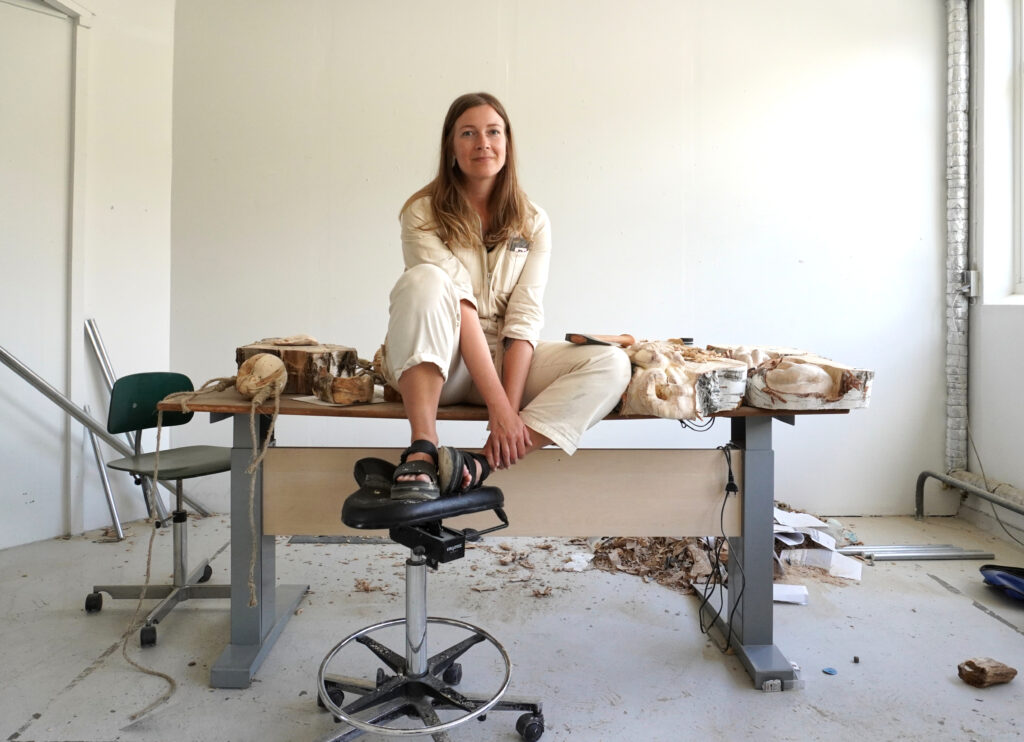
By Nathalie Türck Østergaard
A loud noise greets me from behind the closed door. The final polishing is happening these days. Inside, the studio is full of wood dust and shavings, and the wooden sculptures, from which they have been removed, are scattered around the studio.
A combination of wood workshop and operating theatre, this is where Camilla Edström Ödemark has been working for the past three months. The workwear for the surgeries performed in here is an off-white boilersuit, and in this she excavates bodily fragments from pieces of wood. Somehow, Ödemark’s sculptures seem uncanny and extremely delicate at the same time. There is a familiarity in the teeth or organs of the sculptures, except the fact that they grow out of a solid slice of a birch trunk.
“My main interest is borders, and where the borders between a self and something else lie. Which functions they have, and what mechanisms surround these borders. How we self-govern, and how group identities are maintained.”
Camilla is interested in the body, and in the fine line between what belongs to it, and what does not. She talks about how artificial materials like microplastics are introduced and lingers in the living body, or how natural parasites like fungi or insects can live in symbiosis with the host organism. The exchange that inspires her is between the human and non-human, and between the dead and living, as when a buried dead body decomposes into the soil. Camilla ensures me that she is in no way religious but tells me that she finds some comfort and hope in knowing this. “It’s super scary but I also see something in there that is very democratic. I see the concept of decomposition as ideologically utopian in a way.” When the body dissolves into the ground, instead of being an individual, it becomes a unity with everything, she explains. “Maybe what I’m doing in my art, is trying to find these borderlands where something blends with something else.”
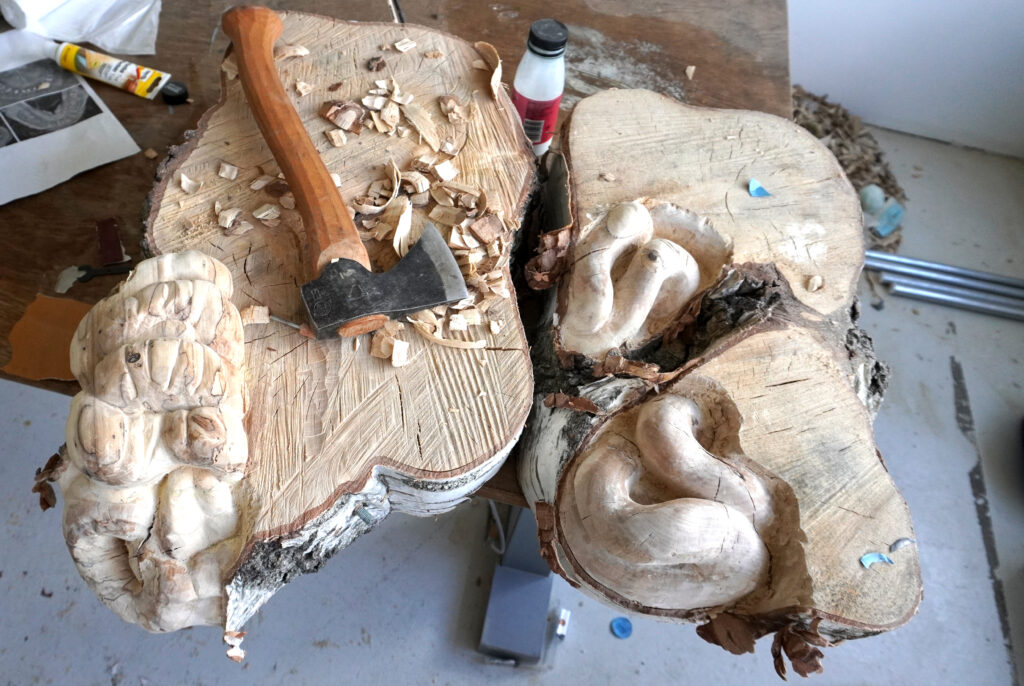
Birch sculptures in process at FABRIKKEN 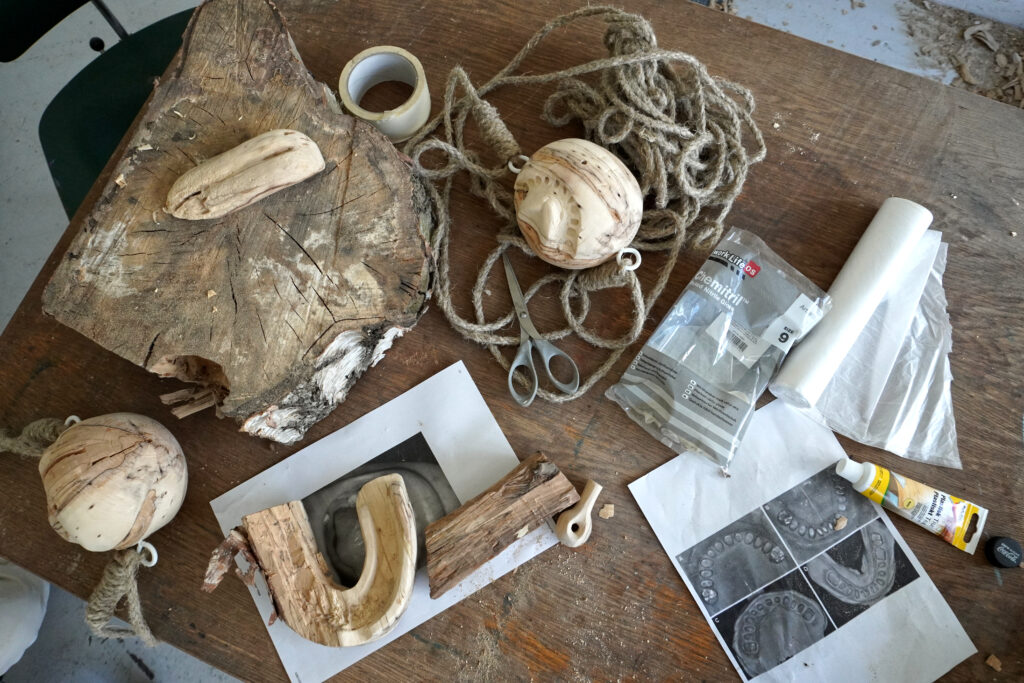
Birch sculptures in process at FABRIKKEN
Organic materials and old traditions
In her previous work, the clash of the natural and artificial are key elements. In ‘Vanitas’ from 2020, the constellation of dead and living materials make up a modern-day nature morte. Clay casts of broken bones are restored or extended with silicone or epoxy and held together with large metal screws. Around them, artificial flowers and moldy grapes are exhibited alongside locks of hair and a digital clock, that point to time’s influence on different materials. In the sculptural works Camilla has produced at FABRIKKEN, she focuses solely on wood. The different states of the chosen wood show how both the living and the dead and everything in between can be contained in one piece, as one part is perfectly even and polished soft, and another full of cracks and wormholes.
“I really enjoy when the material itself decides the outcome, and I need to constantly renegotiate the result or my initial idea. For example, this wood that I have chosen to work with is rotten, and some parts break or shrink, so I need to find new ways of working around that. It is very nice to be in contact with this material. I’m not inventing anything, but it is nice to find my way into a tradition, that I know has been there so long before me, and to think about all those hands that have been struggling with the same things as I am now.”
Camilla’s work from her residency in Copenhagen can be seen as a pragmatic animism. The body parts that inhabit the tree trunks are a way of animating the natural material, but without the enchantment of spiritualism. By giving the wood human features, she points to the fact that humans and nature both are living organisms.
Borders of languages
For Camilla, borders should be understood in its original meaning too – as the line that divides two countries. National identities have played an important role in her life and the history of her family in their search for a national identity. Originally from Åland, a Swedish-speaking island in the south-west archipelago of Finland, Ödemark was raised bilingual, but chose the Swedish language from a young age. She explains that her family has struggled with shame and discrimination over their Finnish language, and Camilla herself has experienced how it has been hard to find her roots both as a Swede in Finland, and as a Finn in Sweden.
“Our family language has defined relationships, but also my own interest for my own identity – what am I? Language is a big part of that, and it has always been very present in my life”, she says.
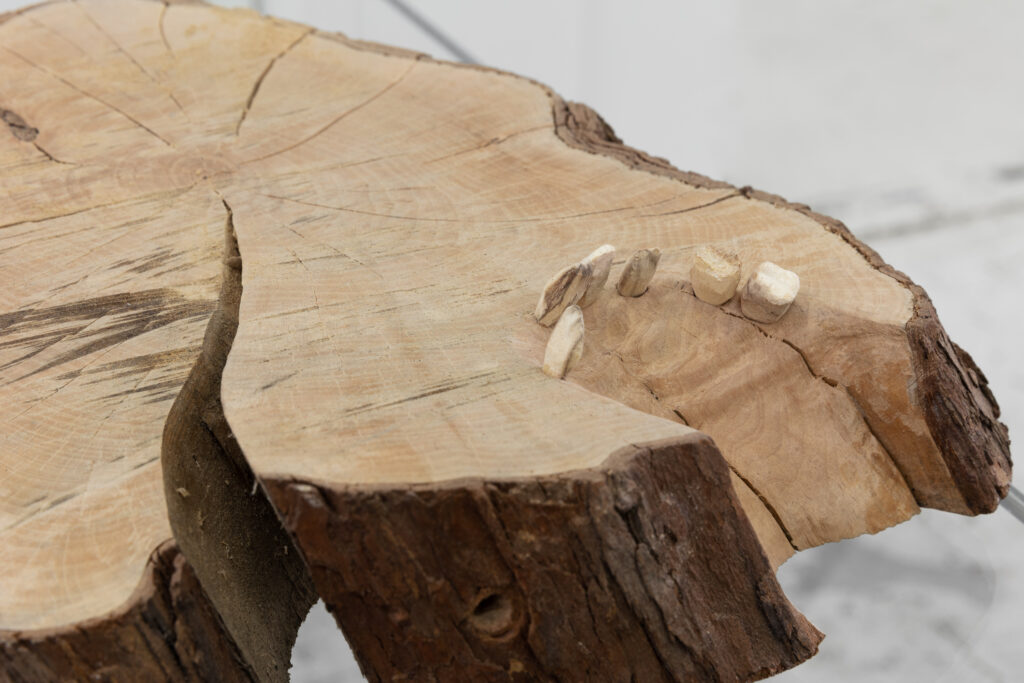
From the exhibition “Mouth Pieces” at Bærum Kunsthall. Picture by KUNSTDOK / Tor S Ulstein
Her grandparents met in the Forest of Finns in Sweden, and she is currently working on a project which focuses on that exact geographical area. The project is part of an interregional collaboration called “Falnande Språk” (“Fading Tongues”) where five invited artists are presenting artworks responding to the Forest of Finns, inspired by a journey that they made through the forest last year. The project is going to be exhibited next year alongside historical objects from the Forest of Finns and the culture that it represents.
Her contribution to the project will be a film, which she has been working on here I Copenhagen too. With help from the artist Amr Hatem who also works at FABRIKKEN, she has been filming in the old dioramas at the Zoological Museum in Copenhagen, where stuffed animals are exhibited in their “natural” habitats.
“At the time [of the trip to the Forest of Finns] I was already thinking about these museums that we have here in the West, and how we try to understand the world around us by taking something out of context and putting it in front of us to visualize and highlight it. There is this layering of knowledge as well. You can’t really escape colonialism when you enter a museum, and to me, colonialism is still something that very much shapes our identities in the west, which I think is very visible in museums.”
The act of collecting and choosing what to exhibit in which context, is a hot topic in the curation and communication departments of museums today. This covers both museums of art, cultural and natural history, but even back in 1984 Donna Haraway touched upon the subject in her essay Teddy Bear Patriarchy: Taxidermy in the Garden of Eden, New York City, 1908-36. The text disseminates the problematic relationship between wildlife preservation and taxidermy that dominated some of the American natural history museums in the in the beginning of the 20th century. It helped fuel a discussion about racism, colonialism, and white supremacy in natural history museums – a discussion that continues to be relevant today, and which we still need artists like Camilla to present to us in new ways, that speak to our present time in our present language.
“To me the museum represents language, how we construct language and understand the world around us through these constructions”, Ödemark says.
Residency and mentorship
Right from the time of her arrival in Copenhagen, the studio at FABRIKKEN has been buzzing from her wood project. “I knew that I had to work my ass off with the birch, because I have an exhibition coming up in August. But it is actually quite nice, because I had to start working right away and establish a daily routine, so it didn’t take long before I had a structure of working.”
Though she has been focused on her own work, Camilla has also had the time to meet with her mentor Theis Wendt to discuss her upcoming exhibition at and each of their artistic practices.
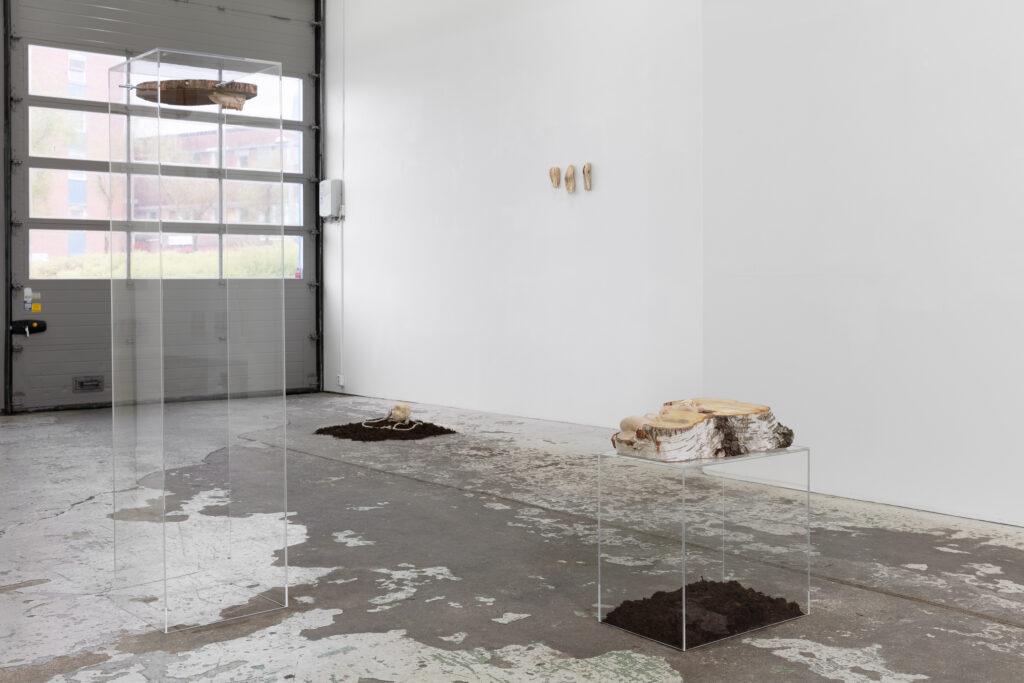
From the exhibition “Mouth Pieces” at Bærum Kunsthall. Picture by KUNSTDOK / Tor S Ulstein
“I didn’t think I would ever have a mentor again after graduating, so this has been really nice. Also, to have Maria [the residency coordinator at FABRIKKEN], who helps me a lot, answering many of my questions. Suddenly all my problems are fixed due to either Theis or Maria. It is so luxurious – I feel like a grown-up baby”, she says and laughs. “Last time I met with Theis, he actually solved all my problems with how to install my exhibition. We have been talking a lot about practicalities and just in general it is nice to hear him talk about his practice, because he has a lot of experience that I don’t have.”
After a fun but labor-intensive three months, Camilla seems content to be going home.
“A residency is a weird place to be, because you enter a working process where you don’t have to compromise at all – where your work is the focus. Period. It is a place where you can be for a specific amount of time because it is quite intense and though I would love to stay, I think three months is the amount of time I can be this focused.” Her hard work seems to have paid off though, as she says: “Now that almost three months have passed, I can’t believe how much work I have done!”
Many thanks to Camilla for coming to Copenhagen and for letting us peek into her artistic process. We look forward to seeing all her many interesting projects come to life.
The birch sculptures from Camilla Edstöm Ödemark’s residency at FABRIKKEN were exhibited in a solo show at Bærum Kunsthall, Norway in August 2021.
Explore more of Edstöm Ödemark’s work on http://www.edstromodemark.com/
FAIR20-21 is kindly supported by the Nordic Culture Point, the Danish Arts Foundation, and the Obel Family Foundation